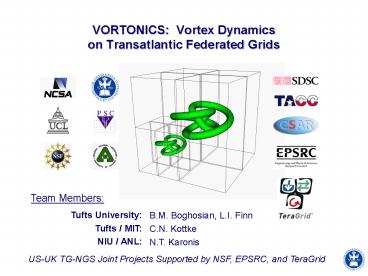VORTONICS: Vortex Dynamics on Transatlantic Federated Grids - PowerPoint PPT Presentation
1 / 6
Title:
VORTONICS: Vortex Dynamics on Transatlantic Federated Grids
Description:
Vortical reconnection governs establishment of steady-state in Navier-Stokes turbulence ... Exact mechanism and space/time scales unknown and represent ... – PowerPoint PPT presentation
Number of Views:23
Avg rating:3.0/5.0
Title: VORTONICS: Vortex Dynamics on Transatlantic Federated Grids
1
VORTONICS Vortex Dynamicson Transatlantic
Federated Grids
US-UK TG-NGS Joint Projects Supported by NSF,
EPSRC, and TeraGrid
2
Scientific Computational Challenges
- Physical challenges Reconnection and Dynamos
- Vortical reconnection governs establishment of
steady-state in Navier-Stokes turbulence - Magnetic reconnection governs heating of solar
corona - The astrophysical dynamo problem
- Exact mechanism and space/time scales unknown and
represent important theoretical challenges - Mathematical challenges
- Identification of vortex cores, and discovery of
new topological invariants associated with them - Discovery of new and improved analytic solutions
of Navier-Stokes equations for interacting
vortices - Computational challenges Enormous problem sizes,
memory requirements, and long run times - Algorithmic complexity scales as cube of Re
- Substantial postprocessing for vortex core
identification - Largest present runs and most future runs will
require geographically distributed domain
decomposition (GD3) - Is GD3 on Grids a sensible approach?
Homogeneous turbulence driven by force of
Arnold-Beltrami-Childress (ABC) form
3
Lattice Remapping, Fourier Resizing,and
Computational Steering
- At its lowest level, VORTONICS contains a general
remapping library for dynamically changing the
layout of the computational lattice across the
processors (pencils, blocks, slabs) using MPI - All data on computational lattice can be Fourier
resized (FFT, augmentation or truncation in k
space, inverse FFT) as it is remapped - All data layout features are dynamically
steerable - VTK used for visualization (each rank computes
polygons locally) - Grid-enabled with MPICH-G2 so that simulation,
visualization, and steering can be run anywhere,
or even across sites
4
Vortex Core Identification and Visualization
- Volumetric methods
- Vorticity magnitude thresholding
- Q criterion
- D criterion
- l criterion
- Extremal Line Integral (ELI) method
- Vortex cores are curves along which the line
integral of vorticity is an extremum in the space
of all curves - VORTONICS includes Ginzburg-Landau solver for
finding and plotting ELI space curves - Addresses problems of reconnection
- Reconnection of elliptic vortex rings
- Aref Zawadski (1991)
- Two publications available on ELI (Phil. Trans.
Roy. Soc. Physica A)
5
Run Sizes to Date / Performance
- Multiple Relaxation Time Lattice Boltzmann
(MRTLB) model for Navier-Stokes equations - 600,000 SUPS/processor when run on one
multiprocessor - Performance scales linearly with np when run on
one multiprocessor - 3D lattice sizes up to 6453 run prior to SC05
across six sites on TG/NGS - NCSA, SDSC, ANL, TACC, PSC, CSAR
- 528 CPUs to date, and larger runs in progress as
we speak! - Amount of data injected into network. Strongly
bandwidth limited. - Effective SUPS/processor
- Reduced by factor approximately equal to number
of sites - Therefore SUPS approximately constant as problem
grows in size
6
Discussion / Performance Metric
- We are aiming for lattice sizes that can not
reside at one SC Center, but - Bell, Gray, Szalay, PetaScale Computational
Systems Balanced CyberInfrastructure in a
Data-Centric World (September, 2005) - If data can be regenerated locally, dont send it
over the grid! (105 ops/byte) - Higher disk to processing ratios - large disk
farms - Thought experiment
- Enormous lattice, local to one SC Center, by
swapping n portions to disk farm - If we can not exceed this performance, it is not
worth using the Grid for GD3 - Make the very optimistic assumption that disk
access time is not limiting - Clearly total SUPS constant, since it is one
single multiprocessor - Therefore SUPS/processor degrades by 1/n, so SUPS
is constant - We can do that now. That is precisely the
scaling that we see now. GD3 is a win! - And things are only going to get better
- Improvements in store
- UDP with added reliability (UDT) in MPICH-G2 will
improve bandwidth - Multithreading in MPICH-G2 will overlap
communication and computation to hide latency and
bulk data transfers - Disk swap in volume, interprocessor
communications on surface, keep in processors!































